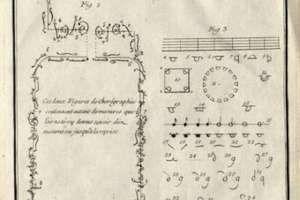ABSTRACT
In the Eighties of the Seventeenth century P. Beauchamps created a graphic method for the transcription of court dances and ballets in tragédies lyriques. Published by R.-A. feuillet in 1700 under the title Chorégraphie ou l’art de décrire la danse, the method spread throughout Europe. It was an ideal meeting between the arts of dance, painting and music since it translated the steps into symbols inspired by musical notes, and organized them in a sort of choreographic map. With the birth of the narrative ballet (1760-1761), J.-G. Noverre remarked the need to find new solutions to represent the two souls of the ballet, the technique and the pantomime, but the real change came with the second ballet reform in the 1780s and 1790s. Among the various choreographers involved in the creation of a notation appropriate to modern dance stands out J.-É. Despréaux, author of a manuscript text dating from 1805 to 1817, whose title Danse-Ecrite ou Terpsi-choro-graphie ou nouvel Essai de Théorie de la danse documents the integration of notation in a very broad theoretical context that revolves around the concept of brotherhood between dance, painting and especially poetry. The symbols of Danse-Ecrite derive from the letters of the alphabet and are aggregated in such a way as to articulate below the musical score as the syllables of the words of the song.
BIOGRAFIA
Flavia Pappacena, dal 1974 al 2012 professore di Teoria della danza presso l’Accademia Nazionale di Danza, dal 2006 insegna Estetica della danza e Teoria della danza alla Facoltà di Lettere dell’Università La Sapienza. Direttore, dal 1993, della rivista di ricerca sulla danza «Chorégraphie», ha pubblicato numerosi testi a carattere teorico-storico tra i quali Excelsior. Documenti e saggi (Roma, Di Giacomo, 1998); Il Trattato di danza di Carlo Blasis (1820-1830) (Lucca, LIM, 2005); La Sténochorégraphie di A. Saint-Léon (Lucca, LIM, 2006); La danza classica. Le origini (Roma-Bari, Laterza, 2009); Programmi di balletti. Selezione di libretti 1751-1776 di J.-G. Noverre (Roma, Audino, 2009); Il Linguaggio della danza classica. Guida all’interpretazione delle fonti iconografiche (Roma, Gremese, 2012); Lettres sur la danse, sur les ballets et les arts (1803) di J.-G. Noverre (Lucca, LIM, 2012); La danza classica tra arte e scienza (Roma, Gremese, 2014, 2018); la sezione sul Settecento e sull’Ottocento di Storia della danza e del balletto di O. Di Tondo, F. Pappacena, A. Pontremoli (Roma, Gremese, 2019). Autrice di saggi e curatrice de Il ballo a Torino dalla Raccolta de’ balli fatti nelle opere del Real Teatro 1748-1762 (Lucca, LIM, 2019).












 Scarica l'articolo
Scarica l'articolo